
|
Today's Calendar |
| | Simply Economics |
| | International Perspective |
| | Resource Center |
 |
|
| 1999 Articles |
|
By Evelina M. Tainer Chief Economist, Econoday Retailers and stock investors have happy holidays
NASDAQ market posts highest return in century; other markets post steady gains 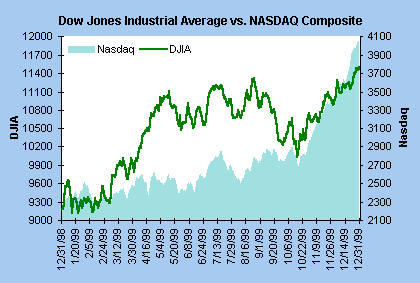 Yet, it was a story of two worlds. The biggest gainers by far were the technology sector. Last week the Wall Street Journal reported that nearly half of the stocks in the NASDAQ composite were down from a year ago. Today, CNBC noted that more than half were down and the top five companies in this market cap weighted index accounted for 25 percent of the total gain. The biggest losers were banks and transportation stocks in this composite index. Even the Russell 2000 was spurred at year's end by the tech sector. Each summer the Russell universe is redefined to remove stocks that no longer fit the criteria. Last July, the tech sector account for 15 percent of this index, by the end of December, it had become the largest sector with nearly 21 percent of the index in market capitalization. 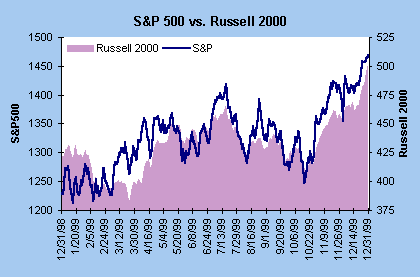 How do investors feel going into the New Year? Most remain bullish, but are pointing to slower gains in 2000. Even market guru Abby Joseph Cohen recently stated that she now feels the stock market is fairly valued in terms of the S&P 500. 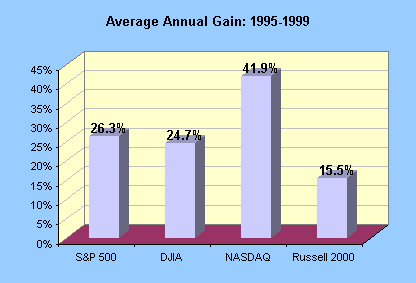
Rising rate environment 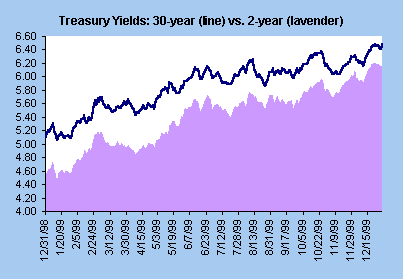
Commodity Markets Gold is a special metal. It can be used in production, as ornament, as an inflation hedge, and as a reserve currency. In times of war or uncertainty, gold usually is a big winner. Despite its inflation-hedge status, gold prices have not kept up with inflation in the 1990s - and gold was generally a poor investment. Central banks around the world hold gold in reserve. Several central banks, as well as the IMF (International Monetary Fund), announced their decisions to sell a good portion of these reserves. The Bank of England carried through several gold sales this past year. Gold bugs in the United States still believe that gold prices signal inflation - or deflation - as the case may be despite the fact that gold sales would have a dampening effect on gold prices. After all is said and done, gold prices aren't giving any clear signals about the direction of the economy or inflation for 2000. 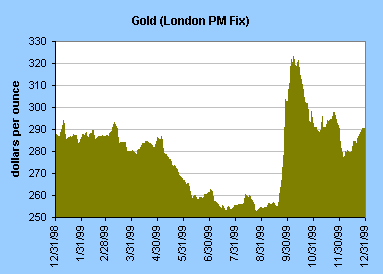 Oil prices staged a dramatic upturn in 1999 after hitting low levels below $12.00 per barrel in late January. OPEC countries set production schedules that so far are on track. As a result, prices of West Texas Crude remained in a tight range of $25 to $27 dollars per barrel in the last month of 1999. Most analysts are predicting that prices will eventually fall back to an $18 to $24 per barrel range. OPEC members often have an incentive to produce more than their scheduled allotment as prices increase. However, improved economies in Europe and Asia along with a robust U.S. market could keep prices near current levels for a bit longer - particularly with a cold winter. 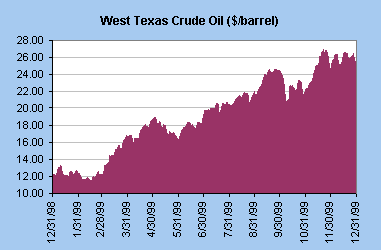
Currency Markets 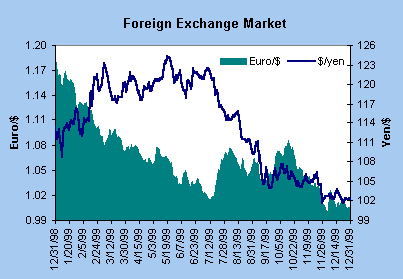
Economic news shuffles in quietly during holiday weeks 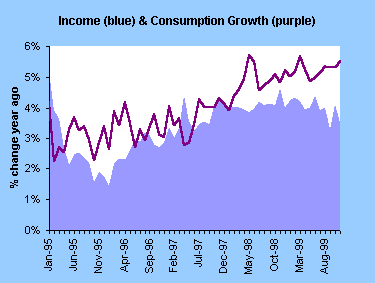 Personal income and outlays for November showed healthy gains during the bond. Yearly gains in consumption continue to outpace year-over-year increases in disposable income. As a result, the personal savings rate remains anemic. 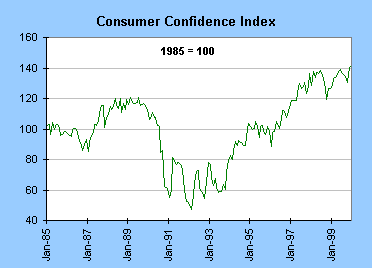 Clearly, the level of consumer optimism is at extraordinary high levels. This comes from low inflation coupled with healthy labor markets. A skyrocketing stock market doesn't hurt. No wonder consumers are happy to be spending and don't feel the urge to save much of their income as their wealth increases in line with stock prices. 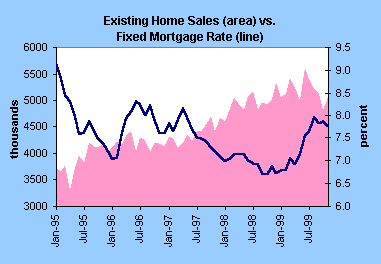 The housing market is usually a leading indicator of economic activity. Federal Reserve officials expected that the higher interest rates would translate into higher mortgage rates and curtail housing demand. Existing home sales jumped in November, but the trend is lower from the summer months. When housing demand moderates, spending on consumer durables such as furniture and appliances is also dampened.
Old News on GDP growth 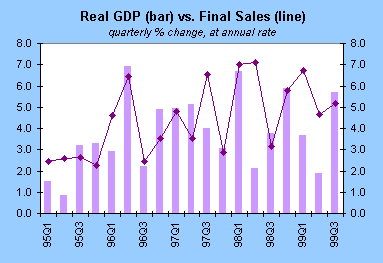 Generally, strong economic activity means healthy revenues and profits - as long as corporations don't have to pay workers higher compensation costs. Thus far, compensation costs are contained - and employers are finding new creative ways to keep their labor and production costs subdued. As a result, after-tax corporate profits are rebounding in 1999 after a long sluggish period in 1998. While the stock market doesn't necessarily move in tandem with profits on a quarterly basis, certainly the two series are related. The recent downturn in the rate of growth in the Dow Jones Industrials doesn't mean that profits will turn lower. Perhaps, they will grow more slowly. 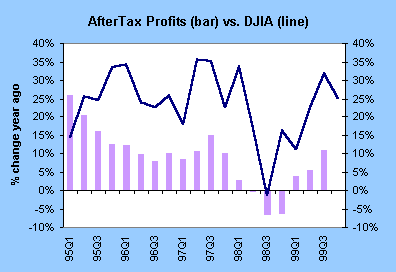
Manufacturing sector growing albeit at a slower rate than the rest of the economy 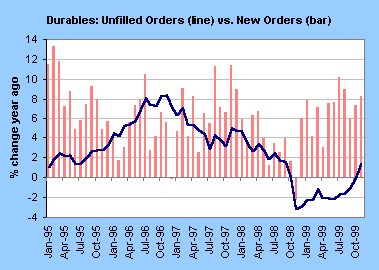 Chicago's purchasing managers' index, which is considered a precursor for the NAPM Survey, decreased modestly in December. Yet, the level of the business barometer remained well above the 50 percent mark and means that this sector is still expanding.
THE BOTTOM LINE As financial market participants and policymakers come back to work after their holiday break, they will be closely monitoring economic news to see if more interest rate hikes will be necessary in February or March to curtail our booming economy. It is helpful that the first week of the new century brings us the December employment report.
Looking Ahead: Week of January 3 to January 7
Monday
Tuesday Motor vehicle sales will start dribbling out in bits and pieces on Tuesday, although the total won't be available until later in the week. Economists are predicting cars were sold at a 7.1 million-unit rate in December and light trucks were sold at a 7.4 million unit pace. Overall, this would be stronger than November sales.
Wednesday
Thursday Economists predict that new home sales will record a 5.2 percent drop in November to a 935,000-unit rate. This is in contrast to existing home sales activity for November - which posted a healthy gain for the month. This could be a correction to last month's unusual spurt.
Friday Average hourly earnings are expected to rise 0.4 percent. If this forecast were realized, it would be a 3.7 percent gain from a year ago. It would also mark the eleventh straight yearly rise under 4 percent for this series. The average workweek should remain unchanged at 34.6 hours. Consumer installment credit is expected to rise at a $7 billion unit rate in November after a more modest $4.2 billion gain in October. This reflects healthy retail spending. |
|||||||||||||||||||||||||||||||||||||||||||||||||||||||||||||||||||||||||